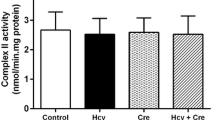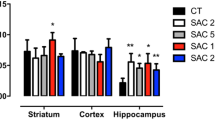Abstract
In the present study we evaluated the effect of acute homocysteine (Hcy) administration on Na+,K+-ATPase activity, as well as on some parameters of oxidative stress such as total radical-trapping antioxidant potential (TRAP) and on activities of antioxidant enzymes catalase (CAT), superoxide dismutase and glutathione peroxidase in rat hippocampus. Results showed that Hcy significantly decreased TRAP, Na+,K+-ATPase and CAT activities, without affecting the activities of superoxide dismutase and glutathione peroxidase. We also verified the effect of chronic pretreatment with vitamins E and C on the reduction of TRAP, Na+,K+-ATPase and CAT activities caused by Hcy. Vitamins E and C per se did not alter these parameters, but prevented the reduction of TRAP, Na+,K+-ATPase and CAT activities caused by Hcy. Our results indicate that oxidative stress is probably involved in the pathogenesis of homocystinuria and that reduction of Na+,K+-ATPase activity may be related to the neuronal dysfunction found in homocystinuric patients.
Similar content being viewed by others
REFERENCES
Mudd, S. H., Levy, H. L., and Skovby, F. 2001. Disorders of transsulfuration. Pages 1279–1327, in Scriver, C. R., Beaudet, A. L., Sly, W. S., and Valle, D. (eds). The metabolic and molecular bases of inherited disease, 8th ed. McGraw-Hill, New York.
Erecinska, M. and Silver, I. A. 1994. Ions and energy in mammalian brain. Prog. Neurobiol. 16:37–71.
Lees, G. J. 1993. Contributory mechanisms in the causation of neurodegenerative disorders. Neuroscience 54:287–322.
Wyse, A. T. S., Streck, E. L., Worm, P., Wajner, A., Ritter, F., and Netto, C. A. 2000. Preconditioning prevents the inhibition of Na+,K+-ATPase activity after brain ischemia. Neurochem. Res. 25:969–973.
Grisar, T. 1984. Glial and neuronal Na+-K+ pump in epilepsy. Ann. Neurol. 16 (Suppl):128–134.
Halliwell, B. and Gutteridge, J. M. C. 1985. Oxygen radicals in the nervous system. Trends Neurosci. 8:22–26.
Welch, G. N., Upchurch, G. R., and Loscalzo, J. 1997. Homocysteine, oxidative stress and vascular disease. Hosp. Pract. 32:81–92.
Hogg, N. 1999. The effect of cyst(e)ine on the auto-oxidation of homocysteine. Free Radical Biol. Med. 27:28–33.
Kubová, H., Folbergrová, J., and Mares, P. 1995. Seizures induced by homocysteine in rats during ontogenesis. Epilepsia 36:750–756.
Streck, E. L., Zugno, A. I., Tagliari, B., Franzon, R., Wannamacher, C. M. D., Wajner, M., and Wyse, A. T. S. 2001. Inhibition of rat brain Na+,K+-ATPase activity induced by homocysteine is probably mediated by oxidative stress. Neurochem. Res. 26:1195–1200.
Fighera, M. R., Queiroz, C. M., Stracke, M. P., Brauer, M. L. N., González-Rodrigues, L. L., Frussa-Filho, R., Wajner, M., and Mello, C. F. 1999. Ascorbic acid and β-tocopherol attenuate methylmalonic acid-induced convulsions. NeuroReport 10:2039–2043.
Jones, D. H. and Matus, A. I. 1974. Isolation of plasma synaptic membrane from brain by combination flotation-sedimentation density gradient centrifugation. Biochim. Biophys. Acta 356:276–287.
Tsakiris, S. and Deliconstantinos, G. 1984. Influence of phosphatidylserine on (Na+ + K+)-stimulated ATPase and acetylcholinesterase activities of dog brain synaptosomal plasma membranes. Biochem. J. 22:301–307.
Chan, K. M., Delfer, D., and Junger, K. D. 1986. A direct colorimetric assay for Ca2+-stimulated ATPase activity. Anal. Biochem. 157:375–380.
Lissi, E., Pascual, C., and del Castillo, M. D. 1992. Luminol luminescence induced by 2,29'-azo-bis(2–amidopropane) thermolysis. Free Rad. Res. Comm. 17:299–311.
Aebi, H. 1984. Catalase in vitro. Methods Enzymol. 105:121–126.
Wendel, A. 1981. Glutathione peroxidase. Methods Enzymol. 77:325–332.
Lowry, O. K., Rosenbrough, R. L., Farr, R. L., and Randall, R. J. 1951. Protein measurement with the Folin phenol reagent. J. Biol. Chem. 193:265–275.
Fuchs, D., Jaeger, M., Widner, B., Wirleitner, B., Artner-Dworzak, E., and Leblhuber, F. 2001. Is hyperhomocysteinemia due to the oxidative depletion of folate rather than to insufficient dietary intake? Clin. Chem. Lab. Med. 39:691–694.
Ames, B. N., Shigenaga, M. K., and Hagen, T. M. 1993. Oxidants, antioxidants and the degenerative diseases of aging. Proc. Natl. Acad. Sci. U.S.A. 90:7915–7922.
Jacobsen, D. J. 2000. Hyperhomocysteinemia and oxidative stress. Time for a reality check? Arterioscler. Thromb. Vasc. Biol. 20:1182–1184.
Malinow, M. R. 1990. Hyperhomocyst(e)inemia. A common and easily reversible risk factor for occlusive atherosclerosis. Circulation 81:2004–2006.
Hitschke, K., Buhler, R., Apell, H. J., and Stark G. 1994. Inactivation of the Na,K-ATPase by radiation-induced free radicals. Evidence for a radical-chain mechanism. FEBS Lett. 353:297–300.
Burton, G. W., Wronska, U., Stone, L., Foster, D. O., and Ingold, K. U. 1990. Biokinetics of dietary RRR-β-tocopherol in the male guinea-pig at three dietary levels of vitamin C and two levels of vitamin E. Lipids 25:199–210.
McCay, P. B. 1985. Vitamin E: interactions with free radical and ascorbate. Annu. Rev. Nutr. 5:323–340.
Frei, B., Stocker, R., England, L., and Ames, B. N. 1990. Ascorbate: the most effective antioxidant in the blood. Adv. Exp. Med. Biol. 264:155–163.
Carr, A. and Frei, B. 1999. Does vitamin C act as a pro-oxidant under physiological conditions? FASEB J. 13:1007–1024.
Hara, H., Kato, H., and Kogure, K. 1990. Protective effect of alpha-tocopherol on ischemic neuronal damage in the gerbil hippocampus. Brain Res. 510:335–338.
Anderson, D. K., Waters, T. R., and Means, E. D. 1988. Pretreatment with alpha-tocopherol enhances neurologic recovery after experimental spinal cord compression injury. J. Neurotrauma 5:61–67.
Sano, M., Ernesto, C., Thomas, R. G., Klauber, M. R., Schafer, S., Grundman, M., Woodbury, P., Growdon, J., Cotman, C. W., Pfeiffer, E., Schneider, L. S., and Thal, L. J. 1997. A controlled trial of selegiline, β-tocopherol, or both as treatment for Alzheimer' disease. N. Engl. J. Med. 336:1216–1222.
Allen, I. C., Grieve, A., and Griffiths, R. 1986. Differential changes in the content of amino acid neurotransmitters in discrete regions of the rat brain prior to the onset and during the course of homocysteine-induced seizures. J. Neurochem. 46:1582–1592.
Kim, W.-K. and Pae, Y.-S. 1996. Involvement of N-methyl-D-aspartate receptor and free radical in homocysteine-mediated toxicity on rat cerebellar granule cells in culture. Neurosci. Lett. 216:17–120.
Author information
Authors and Affiliations
Rights and permissions
About this article
Cite this article
Wyse, A.T.S., Zugno, A.I., Streck, E.L. et al. Inhibition of Na+,K+-ATPase Activity in Hippocampus of Rats Subjected to Acute Administration of Homocysteine Is Prevented by Vitamins E and C Treatment. Neurochem Res 27, 1685–1689 (2002). https://doi.org/10.1023/A:1021647329937
Issue Date:
DOI: https://doi.org/10.1023/A:1021647329937




